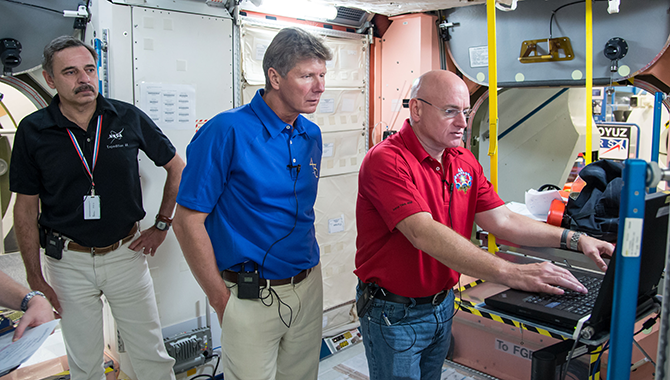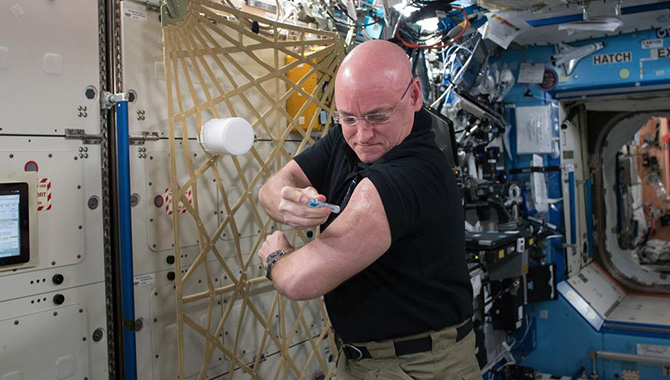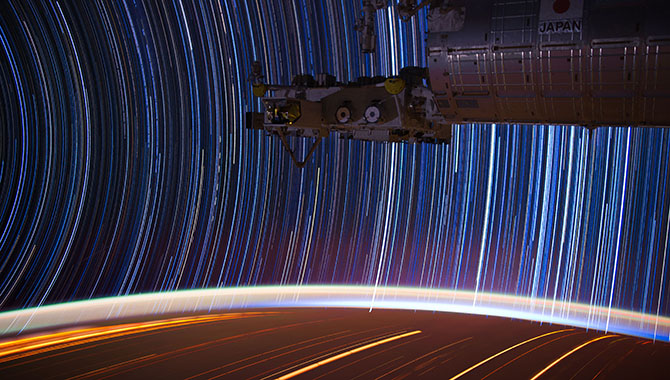
NASA astronaut Scott Kelly preparing for the One-Year Mission in a soyuz simulator at the Gagarin Cosmonaut Training Center.
Photo Credit: NASA/Bill Ingalls
On March 27, 2015, two spaceflight veterans blasted off for a year in low Earth orbit (LEO) that will ultimately help humans travel to Mars.
NASA astronaut Scott Kelly and Russian Federal Space Agency (Roscosmos) cosmonaut Mikhail Kornienko will be the first people to spend 12 months on the International Space Station (ISS). Their One-Year Mission represents an international initiative to advance understanding of the human body’s response to long-duration spaceflight and the challenges that prolonged weightlessness could pose to astronauts who will someday travel beyond LEO.
Speaking to the crew before launch, NASA Administrator Charlie Bolden said, “It’s the beginning of a new phase of exploration between our two countries…and it takes us a little bit farther on the journey to Mars.”
The U.S. and Russia are joined by Europeans, Japanese, and Canadians in the effort to investigate the physical and psychological changes that occur during long-term exposure to microgravity. The mission will focus on a range of scientific investigations that span seven categories. More than 400 experiments are planned for the 12-month period.
Functional investigations will explore the astronauts’ ability to perform functional tasks before, during, and after prolonged weightlessness. This will offer insight into how crew may function when landing on Mars after traveling in a weightless environment for more than seven months.
Behavioral health experiments will examine cognition and sleep to learn more about how stress and fatigue affect mental functioning during spaceflight and after returning to a gravity-based environment.
Studies into visual impairment will explore the impact of long-duration spaceflight on ocular health. Visual impairment is a known consequence of spending time in microgravity, with fluid shifts affecting both eye shape and sight.
Metabolic investigations will examine body chemistry, including cardiovascular and immune system functionality, while microbial investigations will look at the effects of weightlessness on microbial organisms that exist in every human being.
Physical performance studies will advance understanding of the impact of weightlessness on bone, muscle, and the heart. A particular focus will be the hip, which is more susceptible to loss of bone or muscle mass due to microgravity. Counter-measures—such as aerobic activity, weight lifting exercises, and osteoporosis medications—will be examined for their efficacy in keeping the crew strong and healthy.
Finally, investigators will look at human factors: how astronauts interact with their environment, with an emphasis on fine motor performance and the livability of the space station.
Information gathered over the course of the year will be used to support the design of future manned deep space missions as well as to improve the health of people on Earth.
Both astronauts acknowledged that a particular challenge of the yearlong mission is the isolated extreme environment.

Launch of the Soyuz TMA-16M spacecraft carrying one-year crew NASA astronaut Scott Kelly and Russian cosmonaut Mikhail Kornienko, as well as Expedition 43 flight engineer Padalka, to the ISS. Photo Credit: NASA/Bill Ingalls
“As far as a challenge for me, it’s more the psychological aspect of it,” said Kelly. “Maintaining my level of energy throughout the flight, my focus, not feeling all cramped up and wanting to get outside—those kind of things are going to be more challenging.”
In an interview shortly after they arrived on the ISS, Kornienko wasn’t worried about spending a year in space with one other individual. “As far as our psychological compatibility, we have been working really hard on the ground to work that out. And we have lots and lots of support…There will be no problems.” Both men also pointed out that other crew will be on the station with them. Expedition 43 crew members Gennady Padalka, Terry Virts, Anton Shkaplerov, and Samantha Cristoforetti are currently on the ISS. Members of three other expeditions (44, 45, and 46) will rotate through the ISS during the One-Year Mission as well.
Over the course of the mission, Kelly will participate in a unique set of experiments comparing his physiology in LEO to that of his identical twin brother, retired NASA astronaut Mark Kelly, back on Earth. Given that they have the same genetics, even subtle effects of their dramatically different environments may be measurable, adding to the understanding of how long-term exposure to microgravity challenges the human body. The Twins Study includes four categories of investigation: molecular (blood, urine), microbiome (internal bacteria), physiology (whole body), and behavior and thinking.
Findings from the One-Year Mission will be shared across all nations involved with the ultimate goal of advancing human spaceflight far beyond LEO.
Find out why Scott Kelly became an astronaut in this video.
Watch a video about what led Mikhail Kornienko to become a cosmonaut.
Learn more about Scott and Mark Kelly’s Twins Study.
Read a previous APPEL News article about the One-Year Mission









